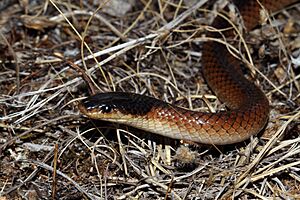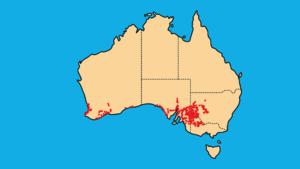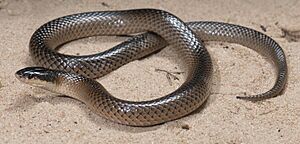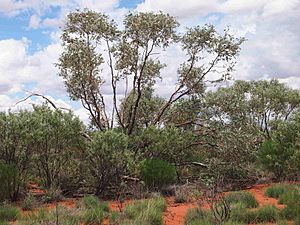Mallee black-backed snake facts for kids
Quick facts for kids Mallee black-backed snake |
|
|---|---|
 |
|
| Conservation status | |
| Scientific classification | |
| Genus: |
Suta
|
| Species: |
nigriceps
|
 |
|
| Synonyms | |
|
|
The Mallee black-backed snake (Suta nigriceps) is a cool snake found in Australia. It's also called the Mitchell's short-tailed snake or just the black-backed snake. This snake is venomous and belongs to a family called Elapidae. You can find it living in many different places across southern Australia.
Contents
Snake Features: What Does It Look Like?
Mallee black-backed snakes are usually between 16 and 53 cm long. The average length from snout to vent (SVL) is about 33 cm. Their tail is fairly short, making up 9 to 15% of their body length.
Their head and neck area are a shiny black color. They have a wide, black stripe running down their back, which is about five scales wide. This stripe goes all the way to their tail.
The scales on their sides are light brown. They have a black or reddish-brown base. The snake's lips and belly are cream or white. The color of the scales gets darker closer to the black stripe on their back. This creates a cool blending effect. These snakes have smooth scales arranged in 15 rows around the middle of their body.
Snake Family: Where Does It Belong?
The Mallee black-backed snake was first described in 1863 by Albert Günther. He named it Hoplochephalus nigriceps. This snake is part of the Suta genus, which includes other venomous snakes.
All Suta snakes are found only in mainland Australia. They belong to the Elapidae family. Elapids are known for having fangs that are always upright at the front of their mouths.
The Mallee black-backed snake is also sometimes placed in the Parasuta genus. Snakes in this group are small and active at night. They give birth to live young and have shiny body scales. They mostly live in the dry parts of southern Australia.
Scientists have changed how they classify smaller elapid snakes many times. This means the Mallee black-backed snake has been placed in different groups over the last 50 years.
Where Do Mallee Black-backed Snakes Live?
Mallee black-backed snakes live across southern mainland Australia. You can find them in New South Wales, South Australia, Victoria, and Western Australia.
This snake is very common in southern Australia. It lives in many different places. These include coastal sand dunes, heathlands, and semi-arid areas. They also live in mallee woodlands, banksia woodlands, and jarrah woodlands.
They especially like temperate semi-arid plains, slopes, and ranges. They are often found in woodlands and hummock grasslands.
Snake Behavior and Diet
Mallee black-backed snakes are active at night (they are nocturnal). They live on the ground (they are terrestrial) and are usually calm. They hide under fallen logs, rocks, thick leaf piles, in cracks in the soil, and in old animal burrows.
These snakes are carnivores, meaning they eat meat. At night, they hunt small skinks and geckos. They also eat other small snakes that compete for the same food. Sometimes, they even hunt small mammals and frogs. They have been known to eat other Mallee black-backed snakes too!
When they catch prey, elapid snakes use their venom and also squeeze their victims (called constriction). They hold onto their prey for a short time after biting. This makes sure enough venom gets into the prey. Their fangs are shorter than some other snakes, so they need to hold on to deliver venom effectively.
Reproduction and Life Cycle
Mallee black-backed snakes are viviparous. This means they give birth to live young instead of laying eggs. On average, a female snake will have four babies at a time. However, some females have been known to give birth to as many as seven live young.
Even though they give birth to live young, it's not exactly like mammals. The baby snakes get their food from a yolk sac inside the mother. They don't get it directly from the mother's bloodstream. Because of this, this type of live birth is sometimes called ovoviviparous.
Predators and Threats to Mallee Black-backed Snakes
Larger snakes, including other Mallee black-backed snakes, often hunt these smaller snakes. Birds, feral cats, and feral dogs also hunt them.
Because they are small, Mallee black-backed snakes are easy targets for predators. To stay safe, they hide inside fallen logs and abandoned burrows. Their coloring also helps them blend in with their surroundings, which is called camouflage.
Mallee black-backed snakes can lose their homes due to cities growing. This can break up their habitat or make it worse. However, this isn't a huge problem for their overall numbers. They can also be affected by damage to their habitat from introduced species like cattle.
Conservation Status
The Mallee black-backed snake is listed as "Least Concern" on the IUCN Red List of Threatened Species. This means that scientists don't think this species is in danger of disappearing right now. There are no special plans in place at a national or state level to protect this snake.
Images for kids






